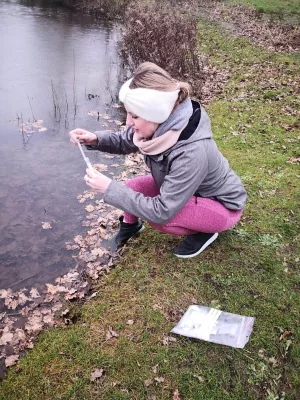
Karolina Brylka
Doctoral student

North Atlantic marine biogenic silica accumulation through the early to middle Paleogene : Implications for ocean circulation and silicate weathering feedback
Author
Summary, in English
The Paleogene history of biogenic opal accumulation in the North Atlantic provides insight into both the evolution of deepwater circulation in the Atlantic basin and weathering responses to major climate shifts. However, existing records are compromised by low temporal resolution and/or stratigraphic discontinuities. In order to address this problem, we present a multi-site, high-resolution record of biogenic silica (bioSiO2) accumulation from Blake Nose (ODP Leg 171B, western North Atlantic) spanning the early Paleocene to late Eocene time interval (~65-34 Ma). This record represents the longest single-locality history of marine bioSiO2 burial compiled to date and offers a unique perspective into changes in bioSiO2 fluxes through the early to middle Paleogene extreme greenhouse interval and the subsequent period of long-term cooling. Blake Nose bioSiO2 fluxes display prominent fluctuations that we attribute to variations in sub-thermocline nutrient supply via cyclonic eddies associated with the Gulf Stream. Following elevated and pulsed bioSiO2 accumulation through the Paleocene to early Eocene greenhouse interval, a prolonged interval of markedly elevated bioSiO2 flux in the middle Eocene between ~ 46 and 42 Ma is proposed to reflect nutrient enrichment at Blake Nose due to invigorated overturning circulation following an early onset of Northern Component Water export from the Norwegian-Greenland Sea at ~ 49 Ma. Reduced bioSiO2 flux in the North Atlantic, in combination with increased bioSiO2 flux documented in existing records from the equatorial Pacific between ~ 42 and 38 Ma, is interpreted to indicate diminished nutrient supply and reduced biosiliceous productivity at Blake Nose in response to weakening of the overturning circulation. Subsequently, in the late Eocene, a deepwater circulation regime favoring limited bioSiO2 burial in the Atlantic and enhanced bioSiO2 burial in the Pacific was established after ~ 38 Ma, likely in conjunction with reinvigoration of deepwater export from the North Atlantic. We also observe that Blake Nose bioSiO2 fluxes through the middle Eocene cooling interval (~ 48 to 34 Ma) are similar to or higher than background fluxes throughout the late Paleocene-early Eocene interval (~ 65 to 48 Ma) of intense greenhouse warmth. This observation is consistent with a temporally variable rather than constant silicate weathering feedback strength model for the Paleogene, which would instead predict that marine bioSiO2 burial should peak during periods of extreme warming.
Department/s
- Lithosphere and Biosphere Science
Publishing year
2021
Language
English
Pages
1937-1954
Publication/Series
Climate of the Past
Volume
17
Issue
5
Document type
Journal article
Publisher
Copernicus GmbH
Topic
- Geology
- Oceanography, Hydrology, Water Resources
Status
Published
ISBN/ISSN/Other
- ISSN: 1814-9324

